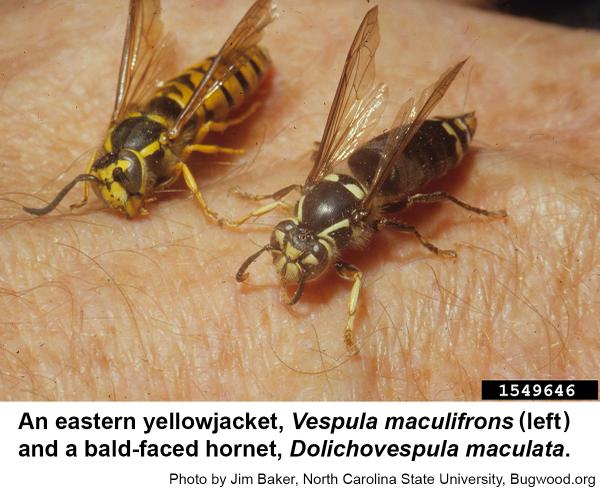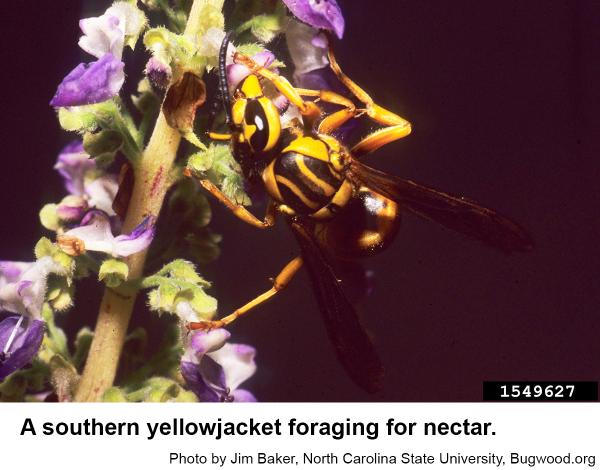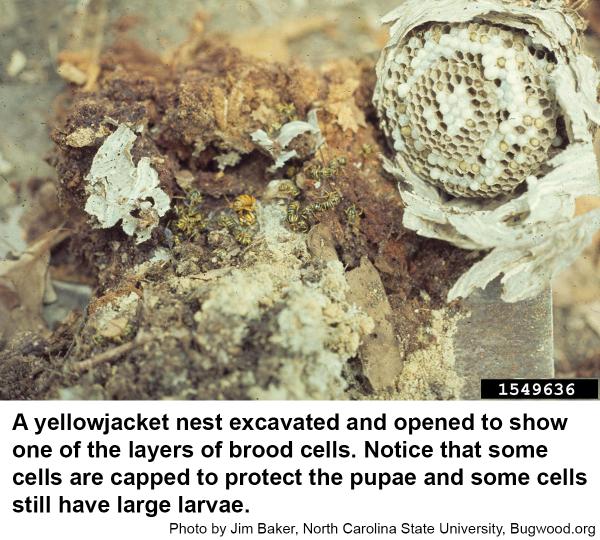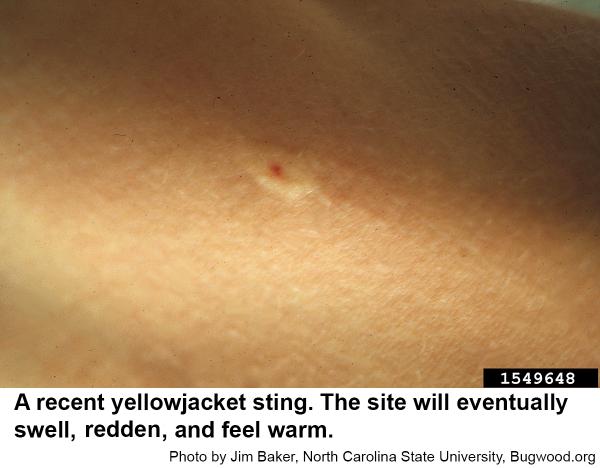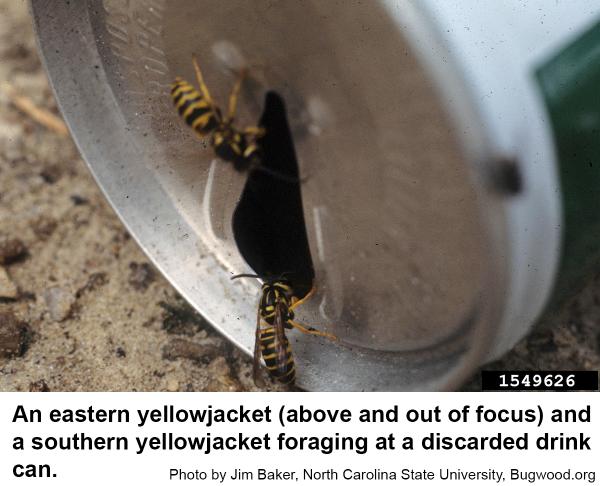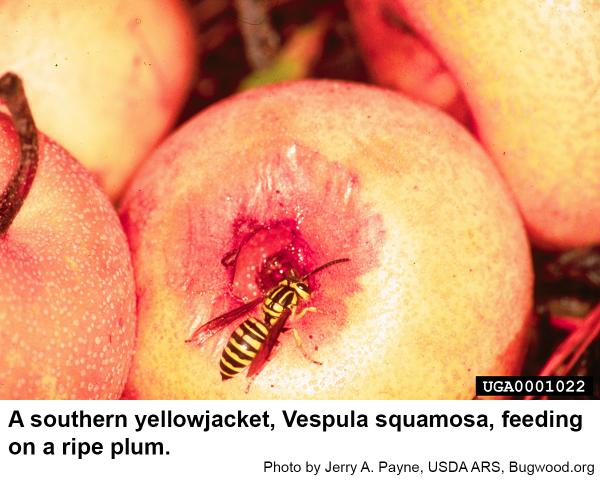Description and Biology
Yellowjackets are about the size of a honey bee, but are yellow with black markings, more slender, and are less hairy. Like honeybees when their hives are disturbed, yellowjackets swarm out aggresively to sting whatever caused the disruption. The eastern yellowjacket, Vespula maculifrons, is the most abundant yellowjacket in North Carolina. Each year up to 40% of the eastern yellowjacket nests are parasitized by other species of yellowjackets, primarily the southern yellowjacket, Vespula squamosa. Eastern yellowjacket colonies not parasitized may reach a population of about 3,000 workers! Queens and males are produced in late summer and early fall. Males don't sting and they have noticeably longer antennae than females. A healthy colony may produce hundreds of queens each of which has the potential to found a new nest the following spring! Yellowjackets do not reuse their old nests (Apparently they do not even reuse the individual cells for new workers and queens). Only mated queens overwinter in a dry, sheltered spot. To establish a nest, each queen has to forage for food, construct the paper brood cells, lay eggs, feed the first brood of worker grubs, and defend the nest from intruders until the first offspring emerge as adults. The new workers then assume all tasks except egg laying. Nests are subterranean and usually occur under a landscape timber or some other inconspicuous place. Occasionally yellowjackets nest in an open meadow or yard so that the nest entrance is wide open. Yellowjackets line the opening, tunnel, and cavity with a gray carton. The nest proper resembles layers of paper wasp nests stacked three or four deep all of which are surrounded by a carton several layers thick.
Hosts
Yellowjackets are attracted to sugar sources such as ripe fruit, nectar, and drink cans. On the benefit side, these wasps kill many insects that attack cultivated and ornamental plants. However, nests near homes may be a hazard. Unfortunately, most folks discover nests by accident when working or mowing nearby. Yellowjackets can sting repeatedly and many workers swarm out of nests aggressively when disturbed. The sting is instantly painful, and the soreness, swelling and itching may persist for days. Some folks are exceedingly allergic to bee and wasp stings. Without prompt medical attention, people hypersensitive to stings may die as a result from a yellowjacket sting.
Residential Recommendations
Yellowjackets are attracted to sugar sources, such as berries, nectar, and drink cans. They also forage on protien sources such as sandwiches and deviled eggs at picnics. To avoid yellowjackets, harvest fruit as it ripens and dispose of rotten fruits where yellowjackets can not reach them.
If you can find them, it is best to eliminate yellowjacket nests at night when the wasps are inside and are relatively calm. Even then, any disturbance will result in instant activity by the colony so work cautiously but quickly, and wear protective clothing. One slow (overnight) but sure way to control a colony of yellowjackets is to use 5% Sevin dust. Dust the entrance liberally with 5 % Sevin dust (maybe two teaspoons). The next day as the workers go in and out, they pick up the dust and track it into the nest. That nest should die out in a day or two (although new adults may emerge from developing pupae for a few days thereafter). Bee and wasp sprays that shoot out 10 to 15 feet can also be directed into the nest entrance. Do not pour gasoline or other fire accelerant down a nest hole. This is extremely hazardous, environmentally unsound, and it kills plants in the vicinity.
Commercial traps advertized for yellowjacket control were developed for Vespula pennsylvanica, a yellowjacket species that occurs out west (in spite of its specific name). The pheromone used in the commercial traps works well for that species but not for our two most prevalent species, the eastern yellowjacket and and southern yellowjacket.
A simple trap using a small piece of raw meat or fish as bait suspended over a pan of soapy water can be quite effective in lowering populations of yellowjackets in local areas. The foraging wasps often "bite off more than they can chew" and drop down as they start to fly away. Once they hit the water, the wasps sink and drown. However, dogs, cats, and other mammals can be attracted to the bait as well so some ingenuity may be required to avoid that unwanted predation. The bait will have to be replaced regularly as yellowjackets are not attracted to rotten meat.
Sometimes, however, it is not possible to find the nest. Aerosols of “flying insect spray” can temporarily protect an area for foraging yellowjackets, These aerosols usually contain various pyrethroids. Try to purchase an aerosol that in addition to the pyrethroid also contains PBO, a synergist that greatly enhances quick knock down.
Other Resources
- Controlling Bald-Faced Hornets and Yellowjackets in and Around Structures, Biting and Stinging Pests. Waldvogel, M., P. Alder, and S. B. Bambara. 2018.
- Common name: yellowjackets and hornets, scientific name: Vespula and Dolichovespula spp. (Insecta: Hymenoptera: Vespidae). Grissell , E. E. and T. R. Fasulo. 2013 (revised). Featured Creatures, Entomology & Nematology. FDACS/DPI, EDIS, UF|IFAS. Publication Number: EENY-81.
- Vespula. Kimsey, L. S. et al. 2021. North American Hornet Screening Tool.
- Yellowjackets of America North of Mexico. Akre, R. D., et al. 1980. U.S. Department of Agriculture, Agriculture Handbook No. 552, 102 pp.
- Extension Plant Pathology Publications and Factsheets
- Horticultural Science Publications
- North Carolina Agricultural Chemicals Manual
For assistance with a specific problem, contact your local Cooperative Extension Center.
This Factsheet has not been peer reviewed.
Publication date: April 5, 2016
Reviewed/Revised: June 22, 2021
Recommendations for the use of agricultural chemicals are included in this publication as a convenience to the reader. The use of brand names and any mention or listing of commercial products or services in this publication does not imply endorsement by NC State University or N.C. A&T State University nor discrimination against similar products or services not mentioned. Individuals who use agricultural chemicals are responsible for ensuring that the intended use complies with current regulations and conforms to the product label. Be sure to obtain current information about usage regulations and examine a current product label before applying any chemical. For assistance, contact your local N.C. Cooperative Extension county center.
N.C. Cooperative Extension prohibits discrimination and harassment regardless of age, color, disability, family and marital status, gender identity, national origin, political beliefs, race, religion, sex (including pregnancy), sexual orientation and veteran status.

